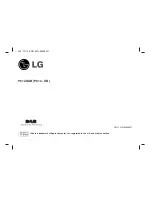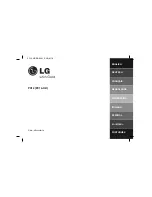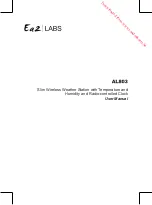
La Crosse Technology, Ltd.
Page 11
Water Tip Test:
Write down the Total Rain reading or reset the Rain Total to 0.00. With Rain
Transmitter mounted, slowly pour water into the funnel to tip the rocker of the rain transmitter 10
times (five each way). Wait at least 2 minutes for all the rain to collect.
Compare these tests. If they still read high, then contact support.
Rain alerts
Set Daily Rainfall Alert
With the rain icon flashing, press ALARM/CHART button to display the rainfall alert.
Hold
ALARM/CHART button until the rainfall alert ALARM HI will flash.
Set the desired value for the rainfall alert by using UP or DOWN arrow button.
Press and hold either button for fast digits advance.
Alert Off
With the rain icon flashing, press the ALARM/CHART button to display either the current rainfall
statistics or the daily rainfall alert with ALARM HI displayed.
Press the UP or DOWN arrow button to enable or disable it.
If the alert is disabled, the OFF will be displayed.
Press ALARM/CHART
button to confirm selection and the weather station will return to the rainfall
alert display.
Winter storage for rain transmitter
All our rain transmitters can handle the cold temperatures. We leave them out all year long. However,
if you prefer to store the rain transmitter for the winter, remember to remove batteries when storing to
prevent leakage.
In the spring, take the rain transmitter out of storage and do a complete
restart
.
When the rain transmitter is outside all winter and is snow covered, you may see a rain count when
the snow begins to melt and run into the rain transmitter. This will not be an accurate measurement
for snow.
Mounting/Positioning outdoor transmitter
First, set up everything in the house to be sure it works before mounting the transmitters outside
.
For best RF (radio frequency) signal, mount all transmitters at least 6 feet in the air.
The thermohygro transmitter sends directly to the weather station.
When considering the distance from the weather station (100 feet open air), cut that distance in half
for each wall, window, tree, bush or other obstruction in the signal path.
Material such as stucco or metal will absorb a wireless signal.
Windows can reflect the signal.
Ideally, the transmitter should be at least 6 feet off the ground (higher is fine) for best signal
transmission.
Place the thermohygro transmitter in a well-shaded area protected from direct sun. The transmitter
will read high if exposed to the sun.
A good location is under the eaves on the North side of the house.
A small roof or well-vented box is useful if you do not have an overhang.
The thermohygro transmitter can withstand rain, snow and temperature extremes.
Standing rain and snow may soak into the transmitter and cause failure.
If the transmitter gets too wet, it will not read accurate humidity.
Ensure the thermohygro transmitter will not be exposed in a downpour.
Light incidental exposure to water typically will not harm the transmitter.
Mounting/Positioning wind transmitter
For most accurate wind readings, mount the wind sensor as the highest item in the area with a 50
foot clearance in all directions (avoid tall trees, buildings or other obstructions that may block or
reflect the wind).
Cup should be on the bottom.





































